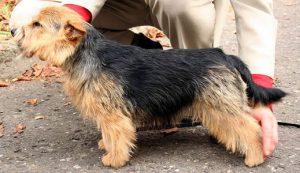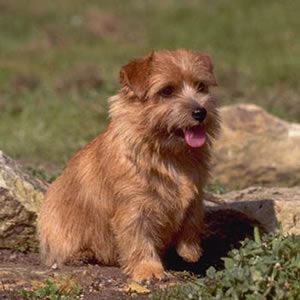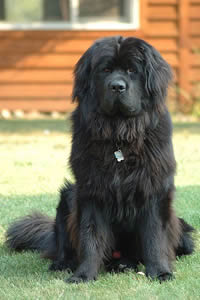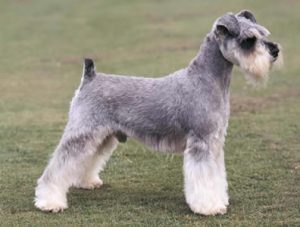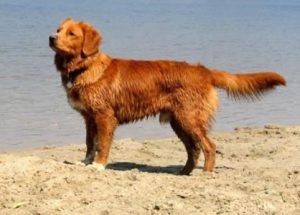
The Nova Scotia Duck Tolling Retriever, or Toller for short, is one of the most unusual breeds of gundog in how the dog works. The hunter stays hidden in a blind and sends the dog out to romp and play near the water, usually by tossing a ball or stick to be retrieved. Just like the fox the dog’s activity and white markings pique the curiosity of waterfowl, who swim over to investigate. The act of enticing or luring game to approach is known as “tolling”. When the birds are close, the hunter calls the dog back to the blind, then rises, putting the birds to flight, allowing him a shot. The Toller then retrieves any downed birds.
Appearance
According to the breed standards, the Toller should be athletic, well-muscled, compact, medium boned, balanced and powerful. The chest is deep. Conformation judges require Tollers to be capable of tolling, and physical faults that inhibit working ability are heavily penalised. They should be of moderate build—a lack of substance or a heavy build are penalised by judges, as both detract from the type and athleticism. The legs are sturdy and solid.
Those who breed Tollers for conformation shows consider the head (clean cut, slightly wedge-shaped) to be an important feature, and believe it should resemble that of a fox and must never be blocky like that of a Golden Retriever. The ears are triangular and set high and well back from the skull.
The tail is well-feathered and held jauntily when the dog is excited or moving.
Coat and colour
Colour is any shade of red, ranging from a golden red through dark coppery red, with lighter featherings on the underside of the tail, pantaloons, and body. Even the lighter shades of golden red are deeply pigmented and rich in colour. The Toller should not be buff or brown. Although very rare, there are chocolate/liver brown Duck Tollers.
The Toller has usually at least one of the following white markings – tip of tail, feet (not extending above the pasterns) chest and blaze. Lack of white is not a fault.
“The Toller was bred to retrieve from icy waters and must have a water-repellent double coat of medium length and softness, and a soft dense undercoat. The coat may have a slight wave on the back, but is otherwise straight. Some winter coats may form a long loose curl at the throat. Featherings are soft and moderate in length. The hair on the muzzle is short and fine. Seasonal shedding is to be expected.” Over-coated specimens are not appropriate for a working dog.
Size and proportions
Tollers are the smallest of all the retriever breeds. Tollers range in height from 17 to 21 inches at the withers, and weigh 37 to 51 pounds (17-23 kg); females are slightly shorter and lighter. Tollers are always a medium-sized breed, never large, however there has been a trend towards larger dogs in recent years.
Tollers should be slightly longer than tall (a ratio of approximately 10 to 9). However, they should not appear long-backed either.
Temperament
“The Toller is highly intelligent, alert, outgoing, loving, and ready for action, though not to the point of nervousness or hyperactivity. It is affectionate with family members and is good with children, showing patience. Some individuals may display reserved behaviour in new situations, but this is not to be confused with shyness… The Toller’s strong retrieving desire coupled with his love of water, endurance and intense birdiness, is essential for its role as a tolling retriever.
—————————————————————————————————————–
CARING FOR YOUR DOG NEWSLETTER – Delivered Directly To Your Inbox – Starting Immediately – SIGN UP FOR FREE TODAY
—————————————————————————————————————–

